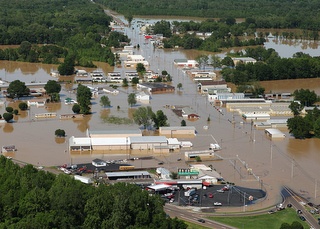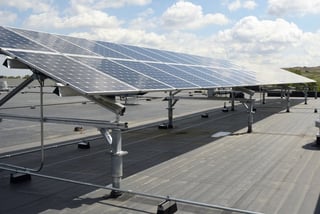If steps 1, 2 and 3 are Energy Efficiency; Green Building; and High Performance, what’s next? Resiliency!
I just returned from the ASHRAE Winter Conference and AHR Expo in Chicago and the many excellent seminars on the usual topics such as sustainability and high-performing buildings, plus three on tall, supertall and megatall buildings that we’ll cover in a future piece since we’re planning on building one in downtown Detroit soon. One seminar in particular piqued my interest, however, as this will be the next big thing - not just for green building, but for building in general.
 Hurricanes, fires, storm surges from the ocean, hotter and colder weather, snowstorms, rainstorms. All of these have been growing in both frequency and intensity, leaving many people injured, without water, without power or left with nothing. That's where resiliency comes in.
Hurricanes, fires, storm surges from the ocean, hotter and colder weather, snowstorms, rainstorms. All of these have been growing in both frequency and intensity, leaving many people injured, without water, without power or left with nothing. That's where resiliency comes in.
Resilience is the New Green
“Resilience is the new green,” said Joel May, Manager, Disaster Durable Solutions, BASF Performance Materials in North America, during his speech at the very first Smart Cities NYC’17, during a panel discussion on “Urban Innovation and the Environment.”
Building owners, suppliers and governments have started addressing resiliency in their products, programs and policies. It’s no longer a question of “What if,” but “When.” Nearly 40% of the U.S. population lives near a coast. But that doesn’t mean the rest of the country is safe – remember the Midwest’s Great Blackout of 2003 when major electrical infrastructure went down? “If your stuff falls apart during an emergency and fails, it’s catastrophic” said May. “This is lives, money and commerce.”
The session I attended, “Resiliency: Building a Safer Future,” included Daniel Nall of Syska Hennessy, New York, NY, on “Making Buildings Resilient,” and Mathew Lieuallen, JD, of Ecology and Environment Inc., Portland, OR, on “State Level Resiliency Planning.” I’d be remiss if I didn’t acknowledge ASHRAE’s Global Climate Change Technical Committee that sponsored this session, and committee chair Beth Tomlinson, of TKDA in St. Paul, MN, who was the moderator.
Resilience is a natural outgrowth of the sustainability movement. Sustainability generally focuses on how much a building impacts the environment. (See What Does Sustainability Mean Today.)
To understand Resiliency, we have to first understand that being an energy efficient, sustainable or even high performance building isn’t going to be enough. Buildings, much like the people who live, work, learn and play there, will need to be resilient in the face of longer, stronger storms, more extreme temperatures, and potential loss of electricity, water and fuel.
Lessons Learned – So Far
So what are many coastal communities already doing that can be applied nationwide? Here in the Heartland, what lessons can we learn and apply to our buildings?
First look at your local codes. Is your community already doing something? If your town, city, county or state has not started implementing regulations, you can seek out other resources (see list at end of article) and start planning. For best results, follow these steps:
- Assess your risks: What are plausible, defensible threats? How far you are from a lake or river will determine your risk for flood damage. Are you near a fault line? Are you in “tornado alley?” Geography is key here.
- Know your desired outcomes: TKDA’s Tomlinson encourages people to “assess building use and identify what the expected response will be for occupants.” For example, hospitals, she notes, will have much different immediate needs than office buildings.
- Define how you will achieve them: I cover some mitigation actions below.
The best time to address building resiliency is in the planning and design phase. During construction may already be too late, but if you can make changes then, you most definitely should. The second-best time to address building resiliency is when you are doing an addition, renovation or deep energy retrofit. Some modifications may qualify for special financing. (See How to Pay for Energy Upgrades.)
The #1 thing is to have a plan in place. Some strategies to consider:
- Waterproof/mold-resistant building materials
- Reinforced building materials
- Flexible space for mechanical equipment needs
- Locating HVAC/mechanical/electrical equipment well above normal high-water levels for your location
- Pervious pavement
- Larger-than-normal detention ponds
- Bioswales and other plantings
- Potable water storage
- Stand-by dual-fuel generators with adequate fuel for a minimum of one week (see below), and load testing at least twice per year
- Alternative power sources such as solar, wind, true geothermal and/or co-generation, and an appropriate place to put them (roof, nearby field, etc.)
You don’t need to be near an ocean to suffer damage from rising waters. If you are near any water source like a lake or river, you need to prepare for water damage. I can’t stress this enough. It’s not a matter of “if.” It’s when!
Which Strategies Will Work For You?
On the coasts as well as those of us inland near lakes and rivers must consider waterproof and mold-resistant materials in new construction and renovations. Pervious pavement, bioswales and other plantings around your building should hold back at least some of the water, minimizing how much water gets into your building and causes damage. These can be attractive options.
Another water damage mitigation strategy that’s gaining traction is moving mechanical and electrical equipment out of basements and subbasements into a higher level of the building, or even to the exterior, but high above ground level. While not as attractive an option, and an expensive one if you’re moving existing equipment, consider the cost of having the equipment take on water, rendering your building unusable for days, possibly weeks or even months. What is the cost in lost productivity or lost rental revenue compared to moving equipment or constructing attractive, above ground housing for this equipment up front?
 For your standby generators, think about what fuel sources you use. If you use a fuel-fired generator, do you keep more than two to three days of fuel on hand? What happens if the trucks can’t get to you to refill your gas or oil? Or what happens if the grid goes down and you can’t get natural gas to your generator?
For your standby generators, think about what fuel sources you use. If you use a fuel-fired generator, do you keep more than two to three days of fuel on hand? What happens if the trucks can’t get to you to refill your gas or oil? Or what happens if the grid goes down and you can’t get natural gas to your generator?
Individual cogeneration systems for your building(s) can “island” the building from the electrical infrastructure when it goes down, i.e. protect it from power loss. Also, renewable power, such as solar panels or wind turbines installed on top of buildings or on nearby property, can generate up to 100 kW or more per day. With other power sources available you have a much better chance of being able to conduct business, including pumping gas, during a blackout.
We are just beginning to scratch the surface on this topic. I’m sure we will continue exploring and implementing this for years to come. If it’s time for a retrofit, contact us. We’ll help you work resiliency into your plan.
Resources on Resiliency:
Oregon Resilience Plan, Jan, 2018 http://www.oregon.gov/gov/policy/orr/pages/index.aspx
BD&C: Resiliency https://www.bdcnetwork.com/resiliency




